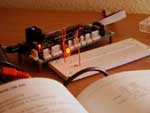I just got an Atmel AVR microcontroller development board in the mail, and have started playing around with it. Hobbyists use these for all kinds of things - from robotics, to data acquisition devices, to lighting modules, etc. Just Google "AVR projects", and you will see what I mean. I've been interested in learning about using microcontrollers for quite a while (ever since Dirk starting building a robot with them in 2001), but for some reason I just haven't buckled down and -tried- them yet. Last night I managed to write code and wire up a circuit to light a single LED. This would be the equivalent of a "Hello World" program in another programming language. It's a humble beginning, but I've already got ideas for lots of cool projects I can build with this thing!



Sup,
If you have any questions…. let me know, I’ve been fiddling with the AVR controllers for quite some time now. I’ve got some nice circuits for RS-232 communications and some visual basic programs for talking to atmels via RS-232. I wrote a visual baisc program to receive a command over the network from a different computer, and then send a command to the atmel to turn on an LED. That’s like “Hello World+” The AVRs come with ADC channels but no way to output an analog signal, I have found some nice DACs to interface with the Atmels for controlling various crud. I’ve started a new blog myself…. I’ll send you a link when I get it fine tuned and ready for prime time. I’m just using the one of the standard templates on blogspot. What are you using
I love how the book is open to the code that you probably used for this project 🙂
You can just use a battery to light an LED! I can’t wait to see what you actually come up with for your first “real” project with these. I’m busy here at work… how much was it for the controller and what’s the interface for the computer?
Actually, I must admit – that photo was a little staged. The book is open to a random page (basically, the middle so the book would stay open) and was pushed closer to the board so it would be in the corner of the photo. 🙂
One of the ideas I am toying with is a set of AVR-controller RGB lighting modules on a RS-485 bus. With 3 LEDs and 255-bit PWM, I should be able to get 24-bit color. With multiple modules, I should be able to do all kinds of cool effects. I’m waiting for some super-bright LEDs to come in the mail so i can start working on the first module – as a ‘proof-of-concept’, so to speak.
The development board was $20, and came with the board, programming cable (it connects to the parallel port), and a CD of ‘documentation’ – which actually was nothing more than datasheets that you can just download off of the web. Not even the AVR assembler – which is free by the way. Sheesh!